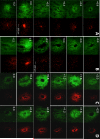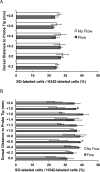Experimental evaluation and computational modeling of tissue damage from low-flow push-pull perfusion sampling in vivo
- PMID: 25614385
- PMCID: PMC4331210
- DOI: 10.1016/j.jneumeth.2015.01.019
Experimental evaluation and computational modeling of tissue damage from low-flow push-pull perfusion sampling in vivo
Abstract
Background: Neurochemical monitoring via sampling probes is valuable for deciphering neurotransmission in vivo. Microdialysis is commonly used; however, the spatial resolution is poor.
New method: Recently push-pull perfusion at low flow rates (50nL/min) has been proposed as a method for in vivo sampling from the central nervous system. Tissue damage from such probes has not been investigated in detail. In this work, we evaluated acute tissue response to low-flow push-pull perfusion by infusing the nuclear stains Sytox Orange and Hoechst 33342 through probes implanted in the striatum for 200min, to label damaged and total cells, respectively, in situ.
Results: Using the damaged/total labeled cell ratio as a measure of tissue damage, we found that 33±8% were damaged within the dye region around a microdialysis probe. We found that low-flow push-pull perfusion probes damaged 24±4% of cells in the sampling area. Flow had no effect on the number of damaged cells for low-flow push-pull perfusion. Modeling revealed that shear stress and pressure gradients generated by the flow were lower than thresholds expected to cause damage. Comparison with existing methods.Push-pull perfusion caused less tissue damage but yielded 1500-fold better spatial resolution.
Conclusions: Push-pull perfusion at low flow rates is a viable method for sampling from the brain with potential for high temporal and spatial resolution. Tissue damage is mostly caused by probe insertion. Smaller probes may yield even lower damage.
Keywords: Brain tissue damage; Cell viability; Computational modeling; In vivo sampling; Microdialysis; Push–pull perfusion.
Copyright © 2015 Elsevier B.V. All rights reserved.
Figures






Similar articles
-
Demonstration of low flow push-pull perfusion.J Neurosci Methods. 2002 Nov 15;121(1):93-101. doi: 10.1016/s0165-0270(02)00245-5. J Neurosci Methods. 2002. PMID: 12393165
-
Push-pull perfusion sampling with segmented flow for high temporal and spatial resolution in vivo chemical monitoring.Anal Chem. 2011 Jul 1;83(13):5207-13. doi: 10.1021/ac2003938. Epub 2011 Jun 7. Anal Chem. 2011. PMID: 21604670 Free PMC article.
-
Microfluidic chip for low-flow push-pull perfusion sampling in vivo with on-line analysis of amino acids.Anal Chem. 2005 Nov 1;77(21):7067-73. doi: 10.1021/ac0510033. Anal Chem. 2005. PMID: 16255611
-
Simultaneous comparison of cerebral dialysis and push-pull perfusion in the brain of rats: a critical review.Neurosci Biobehav Rev. 1998 May;22(3):371-87. doi: 10.1016/s0149-7634(97)00025-0. Neurosci Biobehav Rev. 1998. PMID: 9579326 Review.
-
["Push-pull" perfusion technic in neuroendocrinology].Ann Endocrinol (Paris). 1987;48(5):410-8. Ann Endocrinol (Paris). 1987. PMID: 2893578 Review. French.
Cited by
-
Computational Modeling as a Tool to Drive the Development of a Novel, Chemical Device for Monitoring the Injured Brain and Body.ACS Chem Neurosci. 2023 Oct 4;14(19):3599-3608. doi: 10.1021/acschemneuro.3c00063. Epub 2023 Sep 22. ACS Chem Neurosci. 2023. PMID: 37737666 Free PMC article.
-
Label-free time- and space-resolved exometabolite sampling of growing plant roots through nanoporous interfaces.Sci Rep. 2019 Jul 16;9(1):10272. doi: 10.1038/s41598-019-46538-5. Sci Rep. 2019. PMID: 31312009 Free PMC article.
-
Microdialysis and microperfusion electrodes in neurologic disease monitoring.Fluids Barriers CNS. 2021 Dec 1;18(1):52. doi: 10.1186/s12987-021-00292-x. Fluids Barriers CNS. 2021. PMID: 34852829 Free PMC article. Review.
-
Use and Future Prospects of in Vivo Microdialysis for Epilepsy Studies.ACS Chem Neurosci. 2019 Apr 17;10(4):1875-1883. doi: 10.1021/acschemneuro.8b00271. Epub 2018 Jul 23. ACS Chem Neurosci. 2019. PMID: 30001105 Free PMC article. Review.
-
Numerical Modeling of Electroosmotic Push-Pull Perfusion and Assessment of Its Application to Quantitative Determination of Enzymatic Activity in the Extracellular Space of Mammalian Tissue.Anal Chem. 2017 Jun 6;89(11):5864-5873. doi: 10.1021/acs.analchem.7b00187. Epub 2017 May 11. Anal Chem. 2017. PMID: 28447456 Free PMC article.
References
-
- Benveniste H, Drejer J, Schousboe A, Diemer NH. Regional cerebral glucose phosphorylation and blood-flow after insertion of a microdialysis fiber through the dorsal hippocampus in the rat. Journal of Neurochemistry. 1987;49:729–34. - PubMed
-
- Cellar NA, Kennedy RT. A capillary-PDMS hybrid chip for separations-based sensing of neurotransmitters in vivo. Lab on a Chip. 2006;6:1205–12. - PubMed
-
- Clapp-Lilly KL, Roberts RC, Duffy LK, Irons KP, Hu Y, Drew KL. An ultrastructural analysis of tissue surrounding a microdialysis probe. Journal of Neuroscience Methods. 1999;90:129–42. - PubMed
Publication types
MeSH terms
Substances
Grants and funding
LinkOut - more resources
Full Text Sources
Other Literature Sources

